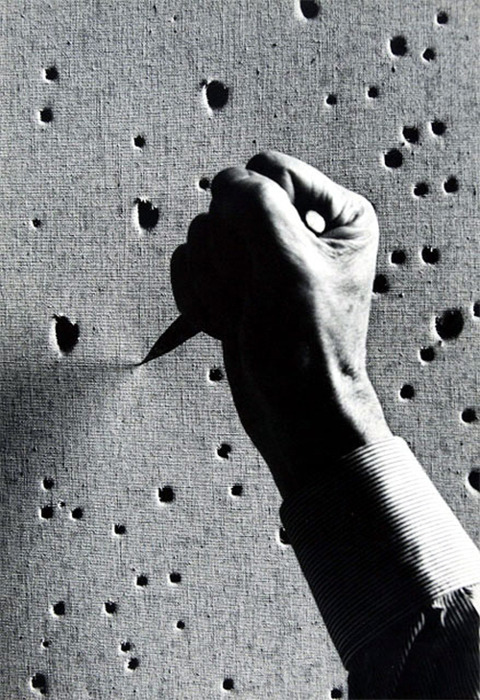




Fontana first began puncturing the surface of paper or canvas in the late 1940s, blurring the distinction between two and three dimensionality. Recognising the importance of this innovation, he continued, through the 1950s and 1960s, to seek different ways of developing the hole as his signature gesture. The first Tagli were made in the late summer and early autumn of 1958. They comprised small, often diagonal incisions, composed in groups over unprimed canvases. During 1959 these tentative slits evolved into single, more decisive slashes, as in the present work. Each cut was made with a single gesture using a sharp blade, and the canvases were then backed with strong black gauze giving the appearance of a void behind. In 1968 Fontana told an interviewer that, 'my discovery was the hole and that's it. I am happy to go to the grave after such a discovery' (quoted in Whitfield, p.12).
Fontana experimented with both the size and shape of the Tagli and painted a number of the canvases in bright monochrome colours. From the earliest works in the series, he wrote the word 'Attesa', meaning 'expectation' or 'hope', on the back of all the canvases with one cut, and 'Attese' (plural) on all those with multiple cuts. This added a temporal dimension to the generic title 'Spatial Concept', which he gave to all his works from the late 1940s. In 1966 Fontana presented an entire room of white Tagli at the Venice Biennale, claiming that he had found a way of 'giving the spectator an impression of spatial calm, of cosmic rigour, of serenity in infinity' (Crispolti, p.38).
In the instances where Fontana slashed an unpainted canvas, as in the present work, there is a particular affinity between the rawness of the surface and the primordial character of the gesture itself. Destruction and creation were bound together in these works. The same gesture that negated the canvas as a purely pictorial vehicle also opened up its sculptural possibilities. 'Art dies but is saved by gesture', Fontana wrote in 1948 (Lucio Fontana 1899-1968: A Retrospective, exhibition catalogue, Solomon R. Guggenheim Museum, New York 1977, p.19). Such rhetoric was characteristic of Spazialismo, the movement he founded in 1947 when he returned to Milan after spending the war years in Buenos Aires.
echt moooooooie kunst
ReplyDeletesvekke - 2k17